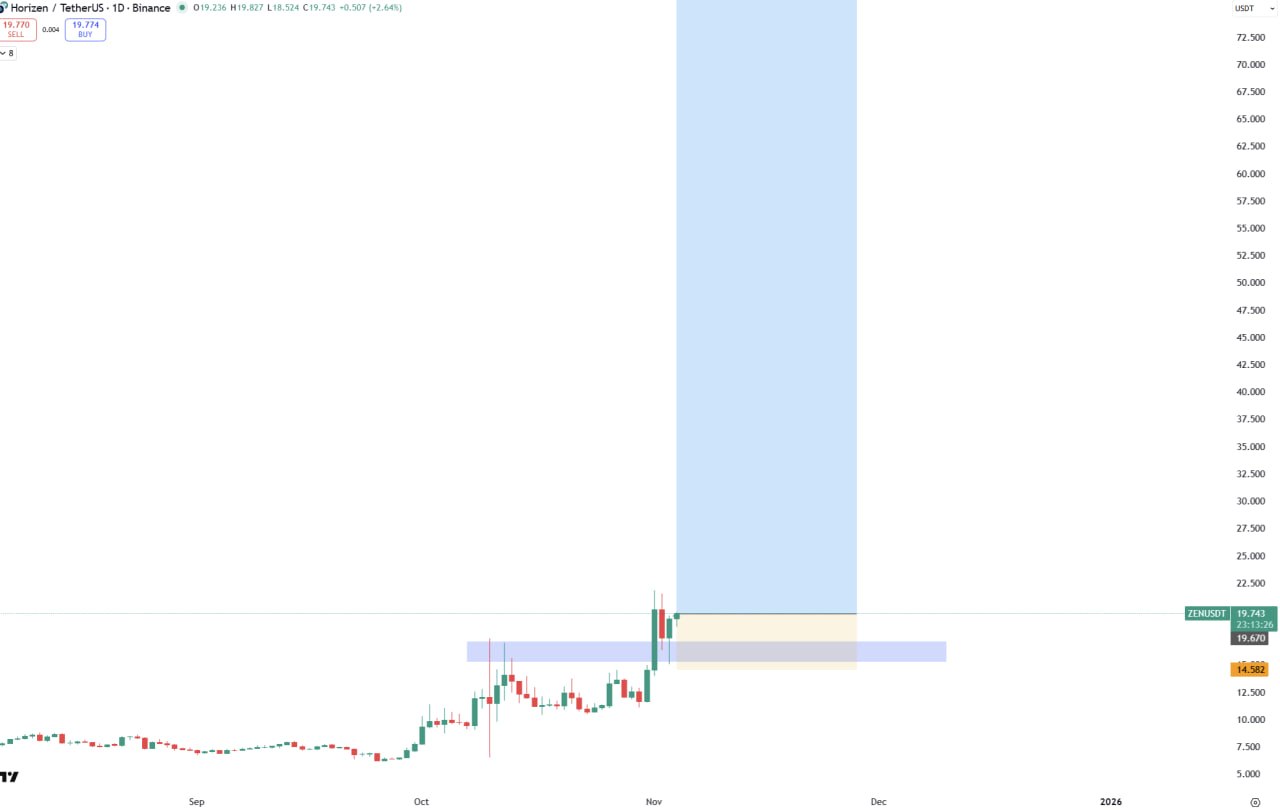ZK/USDT.P — Long
2025-10-31 09:49
Long ZK at 0.03656 with laddered targets at 0.042, 0.58 and 0.76; hard invalidation 0.02414.

If the TradingView symbol is unavailable, use the annotated image as reference for target zones & invalidation.
ZK/USDT.P Long Trade Signal — October 31, 2025
This plan frames a long campaign in ZK around 0.03656, with tiered take-profits at 0.042, 0.58, and 0.76 and a hard stoploss at 0.02414. The unusually wide upper targets reflect a dual-mode thesis: first, a modest mean-reversion toward nearby supply (0.042), and second, a tail scenario in which volatility expansion and narrative reflexivity drive outsized extensions (0.58 → 0.76)—rare but worth planning for in thin, momentum-prone instruments. Our objective is not to predict a moonshot but to design exits that monetize both the base case and the unlikely, high-payoff path if it appears.
Market Context
In the current market regime, capital gravitates to narratives that compress complex technology into simple tags—“ZK,” “AI,” “restaking.” Tokens with those tags often trade as options on attention: quiet for long stretches, then violent when catalysts coalesce. ZK fits that profile. The broader alt complex has seen breadth improve after a period of de-risking; however, liquidity remains selective. That environment rewards process over prediction: wait for structure, insist on precision entries, and harvest partials early.
Another contextual point: small-cap perps are increasingly influenced by programmatic flows—grid systems, basis traders, and headline-chasing bots. Those flows leave fingerprints: repeating wick patterns at the edges of ranges, abrupt squeezes through resting offers, and volume spikes that fade unless spot demand follows. The plan below integrates those realities by emphasizing level-to-level execution and explicit invalidation, rather than narrative conviction.
Technical Analysis
Structure: On the 4H, ZK carved a base between ~0.030 and ~0.036 before breaking above the range high and accepting in the 0.036–0.039 pocket. Retests into 0.035–0.036 have seen absorption, with lower wicks repeatedly reclaimed. The immediate resistance sits near 0.042, corresponding to a prior breakdown shelf and a band where offers typically refresh. Acceptance above that band, if it occurs on expanding volume, can transition price into a higher volatility state where prior anchors lose relevance and air pockets become possible.
- Trend: Micro uptrend on 1H/4H after prolonged compression; daily still range-bound but attempting to turn.
- Momentum: Momentum builds after volatility contraction; look for a squeeze through 0.040 with increasing volume and balanced funding for confirmation.
- Volume: Healthy impulses show expanding participation; chop is marked by decaying turnover and overlapping candles.
- Liquidity: Depth is inconsistent; spreads improve during liquid sessions and degrade in off-hours. Expect slippage if chasing strength.
Key Levels
- Entry: 0.03656 (allow a small tolerance 0.0362–0.0369 for fills)
- Targets: 0.042 → 0.58 → 0.76
- Stoploss: 0.02414 (beneath base failure zone; if touched on a closing basis, thesis invalid)
- Support: 0.0353 (retest shelf), 0.033 (mid-base), 0.030 (base low)
- Resistance: 0.040–0.043 (near-term supply), 0.055–0.065 (historical supply pocket if regime shifts), then vacuum-style zones into the high targets should a news/attention shock arrive.
Execution Blueprint
- Build a core position near 0.03656 once a 1H candle closes back above the retest shelf (~0.0353) after a dip; avoid entries during vertical spikes.
- De-risk with a first partial at 0.042; if price converts 0.042 to support on a closing basis, migrate your stop to just under the most recent 1H higher low.
- Trail the runner using a structure stop (last swing low on 1H/4H) only if momentum persists; do not widen stops into thin liquidity.
- Let convexity work only if breadth expands and order book offers thin materially—signs that the improbable extension is in play. If not, complete the exit per base-case targets and move on.
Failure Signatures
Two successive 1H closes below 0.035 with rising open interest and negative delta suggest distribution; one daily close back inside the 0.030–0.033 pocket argues for a full reset. In both cases, flatten and reassess only after a new base forms.
Risk Management
Trade ZK as a tactical position, not a crusade. Keep per-trade risk small (≤1R of daily budget). Accept that gaps occur and that slippage can exceed models. After the first target pays, you can place a profit lock by lifting the stop above entry, but do so only if structure supports it; arbitrary breakeven stops often lead to whipsaws.
- No averaging down below invalidation; the stop at 0.02414 is final.
- Use limit orders to control price; market orders in air pockets deteriorate expectancy.
- Respect a daily drawdown cap (e.g., −2R); pause when reached—emotional states degrade decision quality.
- Journal execution: reasons for entry/exit, adherence, variance versus plan. Process creates edge.
For educational use only. Not financial advice. Perpetuals and small-cap tokens carry high risk; gaps and slippage can exceed planned losses.








